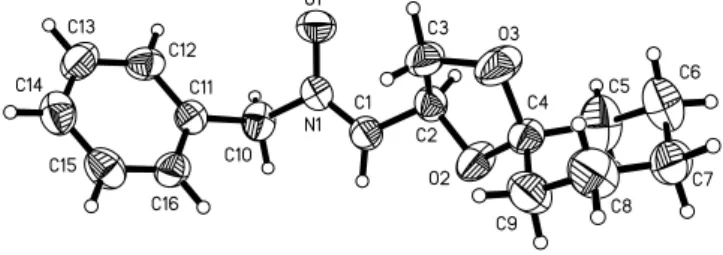Crystal structure of 2,3-O-cyclohexylidene-D-glyceraldehyde N-benzylnitrone, C 16 H 21 NO 3
Wolfgang Frey, Alevtina Baskakova, Andreas Menzel and Volker Jäger
*Universität Stuttgart, Institut für Organische Chemie, Pfaffenwaldring 55, 70569 Stuttgart, Germany Received March 4, 2010, accepted and available on-line April 8, 2010; CCDC no. 1267/2953
Abstract
C
16H
21NO
3, monoclinic, P2
1(no. 4), a = 10.882(3) Å, b = 5.422(2) Å, c = 13.168(3) Å, * = 109.80(2)°, V = 731.0 Å
3, Z = 2, R
gt(F) = 0.062, wR
ref(F
2) = 0.162, T = 293 K.
Source of material
The title compound was obtained [1,2] by reaction of 2,3-O- cyclohexylidene-D-glyceraldehyde [3] and N-benzylhydroxyl- amine in dry dichloromethane in the presence of magnesium sul- fate [4]. The product was purified by recrystallization from ethyl acetate/petroleum ether to give a spectroscopically and analyti- cally pure solid, m.p. 97 - 100 °C (lit. [2]: 88 - 89 °C), [ ] +
D20= 79 (c = 1.28, EtOH), lit. [2]: [ ] +
D20= 82.5 (c = 1.00, EtOH).
Experimental details
H atoms were located on difference fourier map, but refined with fixed individual displacement parameters using a riding model with d(C—H) ranging from 0.93 to 0.98 Å. The Flack’s parame- ter is: x = 1(2) which is meaningless for characterization of the ab- solute configuration.
Discussion
The title compound crystallizes with one independent molecule in the asymmetric unit. The slight lengthening of the N1–O1 dis- tance of 1.293(3) Å is in accordance with polar character of the nitrone function. The N1=C1 double bond is characterized by a distance of 1.289(4) Å. The crystal packing is stabilized by a number of weak interactions. C1–H1 works as donor, and O1 of the nitrone function represents the acceptor. The C1···O1 distance is 3.405(4) Å and the H1···O1 distance is 2.48 Å with an angle
C1–H1···O1 of 173°. Also a weak nearly linear interaction is formed between C9–H9A of a methylene group of the cyclohexyl moiety as donor and O3 of the dioxolane moiety. The distance of the C9···O3 contact is 3.387(5) Å and the H9A···O3 distance is 2.44 Å with an angle C9–H9A···O3 of 164°, which is nearly linear.
Z. Kristallogr. NCS 225 (2010) 245-246 / DOI 10.1524/ncrs.2010.0106
245© by Oldenbourg Wissenschaftsverlag, München
Crystal: colourless block, size 0.25 × 0.3 × 0.7 mm Wavelength: Mo K+radiation (0.71073 Å)
.: 0.86 cm−1
Diffractometer, scan mode: Nicolet P3, Wyckoff
2,max: 53.98°
N(hkl)measured, N(hkl)unique: 6358, 3182 Criterion for Iobs, N(hkl)gt: Iobs> 2)(Iobs), 2460 N(param)refined: 182
Programs: SHELXS-97 [5], SHELXL-97 [6], SHELXTL-Plus [7]
Table 1. Data collection and handling.
H(1) 2a 0.3411 0.4725 0.9508 0.052
H(2) 2a 0.4415 0.1400 0.8487 0.055
H(3A) 2a 0.2703 −0.1257 0.7898 0.072
H(3B) 2a 0.1659 0.0877 0.7715 0.072
H(5A) 2a 0.4702 0.2139 0.6487 0.095
H(5B) 2a 0.4449 0.4941 0.6194 0.095
H(6A) 2a 0.4273 0.2840 0.4622 0.099
H(6B) 2a 0.3274 0.0968 0.4813 0.099
H(7A) 2a 0.2146 0.3741 0.3528 0.080
H(7B) 2a 0.2775 0.5962 0.4291 0.080
H(8A) 2a 0.0994 0.2568 0.4629 0.090
H(8B) 2a 0.0693 0.5355 0.4325 0.090
H(9A) 2a 0.2101 0.6604 0.5996 0.079
H(9B) 2a 0.1122 0.4693 0.6190 0.079
H(10A) 2a 0.3638 0.4154 1.1259 0.060
H(10B) 2a 0.4205 0.1606 1.1770 0.060
H(12) 2a 0.2779 −0.1331 1.2249 0.062
H(13) 2a 0.0850 −0.2026 1.2557 0.073
H(14) 2a −0.0875 0.0637 1.1894 0.069
H(15) 2a −0.0696 0.3987 1.0877 0.068
H(16) 2a 0.1250 0.4779 1.0602 0.059
Table 2. Atomic coordinates and displacement parameters (in Å2)
.
Atom Site x y z Uiso
_____________
* Correspondence author (e-mail: jager.ioc@oc.uni-stuttgart.de)
N(1) 2a 0.3467(2) 0.1502(4) 1.0140(2) 0.040(1) 0.047(1) 0.040(1) 0.002(1) 0.0136(9) −0.003(1) O(1) 2a 0.3472(2) −0.0864(4) 1.0020(2) 0.076(2) 0.042(1) 0.056(1) 0.009(1) 0.024(1) 0.003(1) Table 3. Atomic coordinates and displacement parameters (in Å2).
Atom Site x y z U11 U22 U33 U12 U13 U23
246
C
16H
21NO
3Acknowledgment. We are grateful to Prof. Dr. J. Senn-Bilfinger, Altana Pharma (now Nycomed), Konstanz, for financial support.
References
1. Dondoni, A.: Synthesis of N-Benzyl Nitrones. Synth. Commun. 24 (1994) 2537-2550.
2. Menzel, A.: Stereoselektive CC-Verknüpfung mit Nitronaten und Nitronen - Synthese von Acosamin und Iminopolyolen. Dissertation, Universität Stuttgart (2000).
3. Henneböhle, M.; Le Roy, P-Y.; Hein, M.; Ehrler, R.; Jäger, V.: Isoxazol- inium Salts in Asymmetric Synthesis. 1. Stereoselective Reduction In- duced by a 3'-Alkoxy Stereocentre. A New Approach to Poly- functionalized*-Amino Acids. Z. Naturforsch. 59B (2004) 451-467.
4. Baskakova, A.: Synthesis of Branched+- and*-Amino Acids Using C- Nucleophile Additions to Imines and Nitrones. Dissertation Universität Stuttgart (2009).
5. Sheldrick, G. M.: SHELXS-97. Program for the Solution of Crystal Struc- tures. University of Göttigen, Germany 1997.
6. Sheldrick, G. M.: SHELXL-97. Program for the Refinement of Crystal Structures. University of Göttingen, Germany 1997.
7. Sheldrick, G.M.: SHELXTL-Plus. Structure Determination Software Suite. Release 4.1. Siemens Analytical Systems Inc., Madison, Wiscon- sin, USA 1991.
C(1) 2a 0.3468(2) 0.3042(5) 0.9394(2) 0.043(1) 0.043(1) 0.046(2) −0.004(1) 0.018(1) −0.005(1) O(2) 2a 0.3425(2) 0.4223(4) 0.7662(2) 0.082(2) 0.048(1) 0.037(1) −0.022(1) 0.0144(9) −0.0026(9)
C(2) 2a 0.3558(3) 0.2162(6) 0.8355(2) 0.048(2) 0.049(2) 0.042(1) 0.008(1) 0.018(1) 0.006(1)
O(3) 2a 0.2558(3) 0.0858(4) 0.6621(2) 0.137(2) 0.043(1) 0.049(1) −0.030(1) 0.028(1) −0.007(1) C(3) 2a 0.2507(4) 0.0446(6) 0.7677(3) 0.098(2) 0.038(2) 0.049(2) −0.012(2) 0.032(2) −0.004(1) C(4) 2a 0.2954(3) 0.3336(5) 0.6567(2) 0.055(2) 0.039(1) 0.040(1) −0.012(1) 0.014(1) −0.006(1)
C(5) 2a 0.4043(4) 0.333(1) 0.6098(3) 0.059(2) 0.117(4) 0.057(2) 0.001(2) 0.016(2) 0.004(2)
C(6) 2a 0.3559(4) 0.267(1) 0.4902(3) 0.090(3) 0.099(3) 0.069(2) 0.006(2) 0.042(2) −0.013(2)
C(7) 2a 0.2465(4) 0.4281(8) 0.4274(3) 0.101(3) 0.058(2) 0.042(2) −0.005(2) 0.023(2) −0.005(2)
C(8) 2a 0.1370(4) 0.4210(9) 0.4722(3) 0.082(2) 0.082(3) 0.049(2) 0.021(2) 0.009(2) 0.000(2)
C(9) 2a 0.1839(4) 0.4885(7) 0.5915(3) 0.081(2) 0.064(2) 0.053(2) 0.020(2) 0.023(2) −0.002(2) C(10) 2a 0.3488(3) 0.2387(6) 1.1211(2) 0.052(2) 0.060(2) 0.037(1) −0.013(1) 0.013(1) −0.008(1) C(11) 2a 0.2227(3) 0.1828(5) 1.1400(2) 0.049(1) 0.044(2) 0.029(1) −0.004(1) 0.011(1) −0.006(1) C(12) 2a 0.2088(3) −0.0233(5) 1.1981(2) 0.059(2) 0.043(2) 0.049(2) 0.008(1) 0.012(1) 0.006(1) C(13) 2a 0.0931(3) −0.0654(7) 1.2160(3) 0.078(2) 0.050(2) 0.059(2) −0.012(2) 0.030(2) 0.005(2) C(14) 2a −0.0100(3) 0.0924(7) 1.1762(3) 0.055(2) 0.067(2) 0.054(2) −0.008(2) 0.024(2) −0.012(2) C(15) 2a 0.0011(3) 0.2935(7) 1.1166(2) 0.052(2) 0.065(2) 0.050(2) 0.013(2) 0.013(1) −0.003(2) C(16) 2a 0.1175(3) 0.3396(6) 1.0995(2) 0.064(2) 0.045(2) 0.038(1) 0.005(1) 0.018(1) 0.007(1) Table 3. Continued.
Atom Site x y z U11 U22 U33 U12 U13 U23
